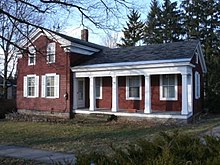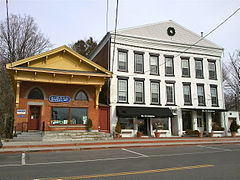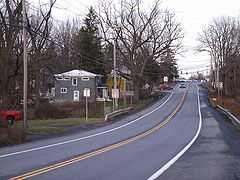Manlius (Town, New York)
| Manlius | |
|---|---|
 Manlius Christ Church |
|
| Location of the Town of Manlius in Onondaga County | |
| Basic data | |
| Foundation : | 1792 (settlement) 1794 (township) 1842 (incorporation) |
| State : | United States |
| State : | new York |
| County : | Onondaga County |
| Coordinates : | 43 ° 3 ′ N , 75 ° 59 ′ W |
| Time zone : | Eastern ( UTC − 5 / −4 ) |
| Residents : | 32.002 (as of: 2018) |
| Population density : | 251 inhabitants per km 2 |
| Area : | 129.38 km 2 (about 50 mi 2 ) of which 127.48 km 2 (about 49 mi 2 ) is land |
| Height : | 204 m |
| Postcodes : | 13057, 13066, 13082, 13104, 13116 |
| Area code : | +1 315 |
| FIPS : | 36-45029 |
| GNIS ID : | 0979192 |
| Website : | www.townofmanlius.org |
| Mayor : | Edmond J. Theobald ( R ) |
Manlius is a city with the status of Town in Onondaga County in the state of New York in the United States . The 2018 American Community Survey estimated the city's population at 32,002 , a decrease in population compared to the 2010 census when Manlius had 32,370 residents. Manlius is a suburb of Syracuse .
geography
location
Manlius is located in Upstate New York in the east of Onondaga County, about 15 kilometers southeast of Syracuse. The city is bordered to the north by Cicero , to the northeast by Sullivan with Chittenango , to the southeast by Cazenovia , to the south by Pompey and to the west by DeWitt .
In the northeast of Manlius is the Green Lakes State Park . The districts of Manlius and Fayetteville are on Limestone Creek , the district of Minoa is on the Erie Canal . The Manlius area has several major highways, the most important of which is New York State Route 5 through Fayetteville. Manlius is on New York State Routes 92 and 173 , Fayetteville is also on New York State Route 257 and Minoa is on New York State Route 290 . North of Minoa also leads Interstate Highway 90 through the city. Minoa is also on the Mohawk Subdivision Railway .
City structure
The Town of Manlius is divided into the Villages Manlius (4520 inhabitants; as of 2018), Fayetteville (4133 inhabitants) and Minoa (3474 inhabitants). The city also includes the Eagle Village, Fillmore Corners, Fremont Heights, Fremont Hills, Highbridge, Kirkville , Mycenae , North Manlius, Peck Hill, Pompey, Saintsville and Shepps Corner settlements.
history
The area around the city was formerly settled by Native Americans of the Oneida and Onondaga tribes until European emigrants came to the area in the late 18th century. The first white settler in the area was Benjamin Moorehouse in 1789. The village of Manlius was founded in 1792 by the German John A. Schaeffer. Fayetteville was founded a year earlier when Joshua Knowlton settled down there. Fayetteville was first known as the Manlius Four Corners after it was founded and was renamed after the local post office was founded. The Town of Manlius was laid out in 1794 as Township Number Seven in the Central New York Military Tract in the course of the establishment of Onondaga County. In addition to today's Town of Manlius, the area also included today's city of DeWitt, which was detached from the area of Manlius in 1835.
Between 1789 and 1803 a Presbyterian, a Baptist and a Congregational church were founded in Manlius. In 1801 there were six residential buildings, a pub, a grocery store, a doctor's office, a law firm and a blacksmith in Manlius. At the beginning of the 19th century, Manlius also received a post office. At that time Manlius showed very rapid growth, three years later the place already had 30 residential buildings. Before the construction of the Erie Canal , Manlius was an important trading place. In 1813 a weaving mill was built in the village, which was destroyed by fire in the 1830s. In 1842 Manlius was incorporated as a village, and Robert Fleming became the first mayor. Two years later, Fayetteville was also incorporated as a Village within the Town of Manlius. In the 19th century, Fayetteville's economy was shaped in particular by coal mining.
education
The public schools in Manlius and Fayetteville are part of the Fayetteville-Manlius Central School District . This includes three primary schools from kindergarten to fourth grade, a middle school from grades five to eight and a high school from grades nine to twelve. In addition to Manlius and Fayetteville, the school district also includes parts of Pompey and the district of Jamesville, which belongs to DeWitt . In the 2019/20 school year, the schools in this school district were attended by around 4,190 students. The district of Minoa belongs to the East Syracuse-Minoa Central School District , in the place there is a primary school. Secondary schools are attended by students from Minoa in East Syracuse .
Before the school districts were established in the 1930s, the town's children attended school in Mycenae. The building was constructed in 1850 and has been listed on the National Register of Historic Places since August 1983 .
Demographics
| Population development | |||
|---|---|---|---|
| Census | Residents | ± in% | |
| 1820 | 5372 | - | |
| 1830 | 7375 | 37.3% | |
| 1840 | 5509 | -25.3% | |
| 1850 | 6298 | 14.3% | |
| 1860 | 6028 | -4.3% | |
| 1870 | 5833 | -3.2% | |
| 1880 | 5954 | 2.1% | |
| 1890 | 5453 | -8.4% | |
| 1900 | 5374 | -1.4% | |
| 1910 | 6016 | 11.9% | |
| 1920 | 6599 | 9.7% | |
| 1930 | 7620 | 15.5% | |
| 1940 | 7845 | 3% | |
| 1950 | 10,221 | 30.3% | |
| 1960 | 19,351 | 89.3% | |
| 1970 | 26,071 | 34.7% | |
| 1980 | 28,530 | 9.4% | |
| 1990 | 30,656 | 7.5% | |
| 2000 | 31,872 | 4% | |
| 2010 | 32,370 | 1.6% | |
| US Decennial Census | |||
In 2018, the American Community Survey estimated the population of Manlius to be 32,002. There were 13,220 households and 8,858 families in the city. There were married couples living in 78.0 percent of families, 7.7 percent were single fathers and 14.3 percent of families were single mothers. 29.6 percent of households had children under the age of 18 living with them, and 46.2 percent of households had people over 60 years of age. Of the population, 89.9 percent were white, 2.6 percent were African American , 4.0 percent were Asian, and 0.2 percent were Native American; 0.8 percent of the residents were of other origins and 2.5 percent of the residents stated several origins. Hispanics or Latinos made up 1.5 percent of the population. 47.9 percent of the population of Manlius were male and 52.1 percent were female.
In terms of age, the population of Manlius was divided into 22.9 percent minors, 5.2 percent between 18 and 24, 21.5 percent between 25 and 44, 29.8 percent between 45 and 64 and 20.6 percent of the population were 65 years of age old or older. The median age was 45.1 years. In 2018, the median manlius income per household was $ 80,068 and per family was $ 101,939. 4.1 percent of the population lived below the poverty line .
gallery
Personalities
sons and daughters of the town
- Born in Manlius
- Truman H. Hoag (1816–1870), politician
- Herbert Huntington Smith (1851-1919), politician
- Franklin Asa Nims (1854–1935), photographer
- Born in Fayetteville
- Rose Cleveland (1846–1918), sister of Grover Cleveland
People related to the city
- Amos P. Granger (1789–1866), politician, temporarily mayor of Manlius
- William Taylor (1791–1865), politician, died in Manlius
- Grover Cleveland (1837–1908), 22nd and 24th President of the United States, grew up in Fayetteville
- Thomas J. McIntyre (1915-1992), politician, went to school in Manlius
- Howard Boatwright (1918–1999), composer and musicologist, lived in Fayetteville
- Thomas Szasz (1920–2012), psychiatrist, lived in Manlius
- Cathy Carr (1936–1988), singer, lived in Fayetteville
- Nina Fedoroff (* 1942), molecular biologist, grew up in Fayetteville
Web links
Individual evidence
- ^ History of Manlius. In: history.rays-place.com , accessed on May 3, 2020.
- ^ Fayetteville-Manlius CSD at a Glance. In: data.nysed.gov , accessed on May 3, 2020.
- ↑ Manlius, New York, Demographic and Housing Estimates. In: data.census.gov , accessed May 3, 2020.








